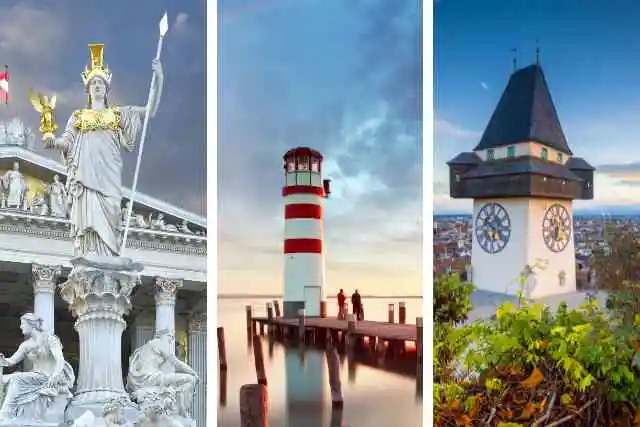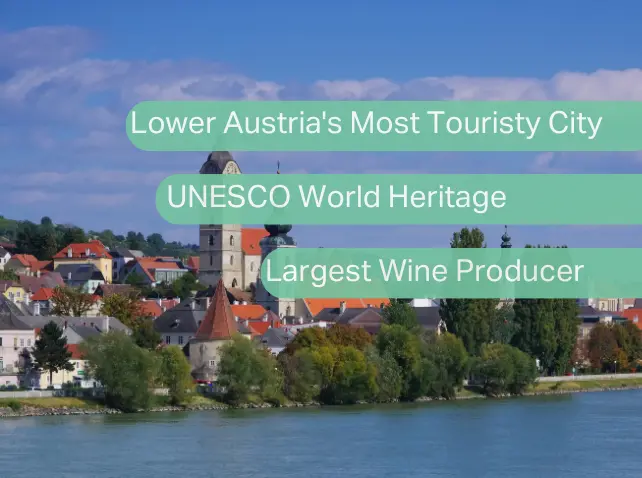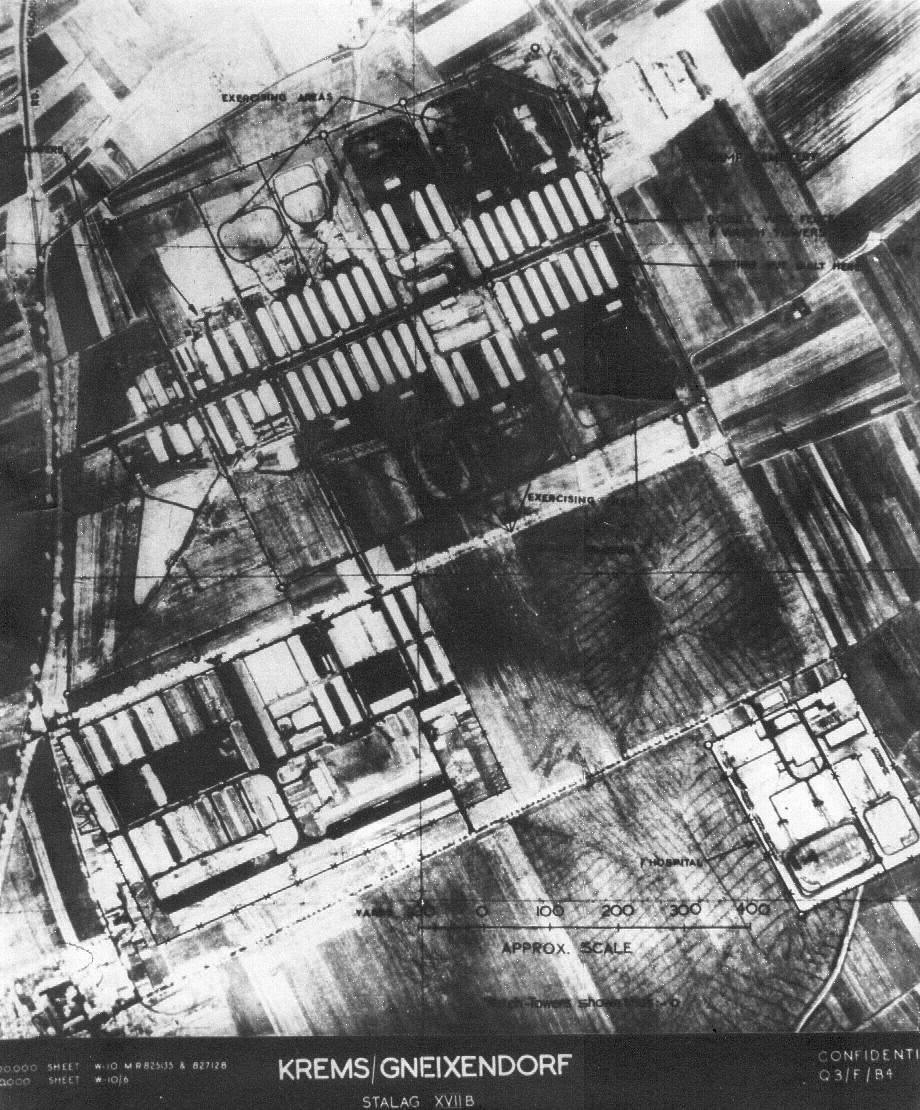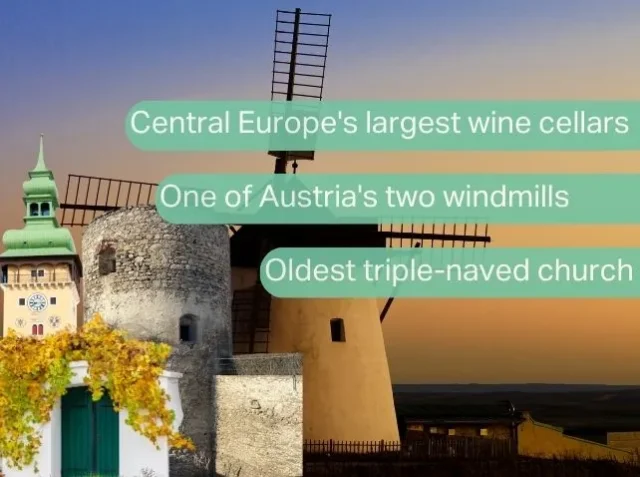Discover dark secrets from the Second World War, the Beethoven family's legacy, and ancient artifacts. Read all about it in the article below!
Krems an der Donau

Book
Austria by Public Transport
Discover Austria like never before with “Austria by Public Transport.” This book is your ultimate guide to exploring the beauty of Austria easily and affordably. Get your copy today and start your adventure!
Krems an der Donau is a beautiful city in the Danube Valley. Additionally, about 25,000 people live here, making it a vibrant community. Moreover, it’s also a popular tourist destination in Lower Austria, with many visitors walking through its picturesque streets. In fact, last year, 239,554 people stayed overnight here, with most visitors coming from Austria (125,969), but many (47,245) arriving from other countries. Furthermore, Krems is the fifth biggest city in Lower Austria, and it’s a special place situated by the Danube river.
Did you know?
The Wachau Valley is a 35-kilometre stretch along the Danube River between Melk and Krems. The Valley is a UNESCO World Heritage Site,
Name
The origin of the name “Krems” remains somewhat unclear, with most researchers agreeing that it likely has Celtic or Slavic roots. Some theories suggest that the name may have originally referred to a sharp-edged stone, such as flint. Others propose that it could have described a bulbous-looking plant or a small stream. Despite the uncertainty, these interpretations highlight the natural and geographical significance that the name “Krems” might have held in ancient times.
The city is unique in its cultural offerings, and before you visit, we recommend you purchase the Niederösterreich-CARD, which allows you to experience many of Krems’ attractions for less than €50. The card is valid for one year and gives access to 350 attractions throughout Austria.
We recommend visiting restaurants such as Altstadt Schmankerl, which has an excellent rating on Google Maps (4.8 stars) and serves local cuisine.
For cafés, try Café-Konditorei Hagmann (4.5 stars) and Kaffee Campus Krems (4.8 stars).
Once you have purchased the NOE-Card, you should definitely visit Krems an der Donau several times. With the Lower Austria Card, you can take the ferry across the Danube and the Wachau Railway.
Wine from Krems an der Donau
Krems is a winemaking town in the Kremstal region. In addition, the perfect combination of warm days and cool nights, fertile loess soil, and rocky rock soil makes its wines exceptional. As a result, they are special and full of character. Furthermore, white wines from the Wachau are among the best in the world.
Did you know?
In addition, Winzer Krems, located in Krems an der Donau, is Austria’s largest wine producer. Notably, this cooperative unites about 750 winemakers to create high-quality wines.
The Historical Vineyards
of Krems an der Donau
Krems has long been a center of winemaking, starting during the Roman era. Moreover, it has famous vineyards like the “Kremser Sandgrube,” known as a symbol of the Grüner Veltliner grape since the 11th century. Additionally, the city has been producing wine for more than 1,000 years. As a result of its strong wine tradition, the city received its rights in 1305. Later, in 1447, winemakers established the guild, which is now the oldest in the German-speaking world. Even today, it proudly maintains a viticulture tradition that has lasted for centuries. Furthermore, in 1938, local vintners founded WINZER KREMS, now the largest wine producer in Austria. Finally, every new winemaker in Krems takes an important pledge, saying, “I swear to be a good Hauer,” which means they will work hard to make exceptional wines.
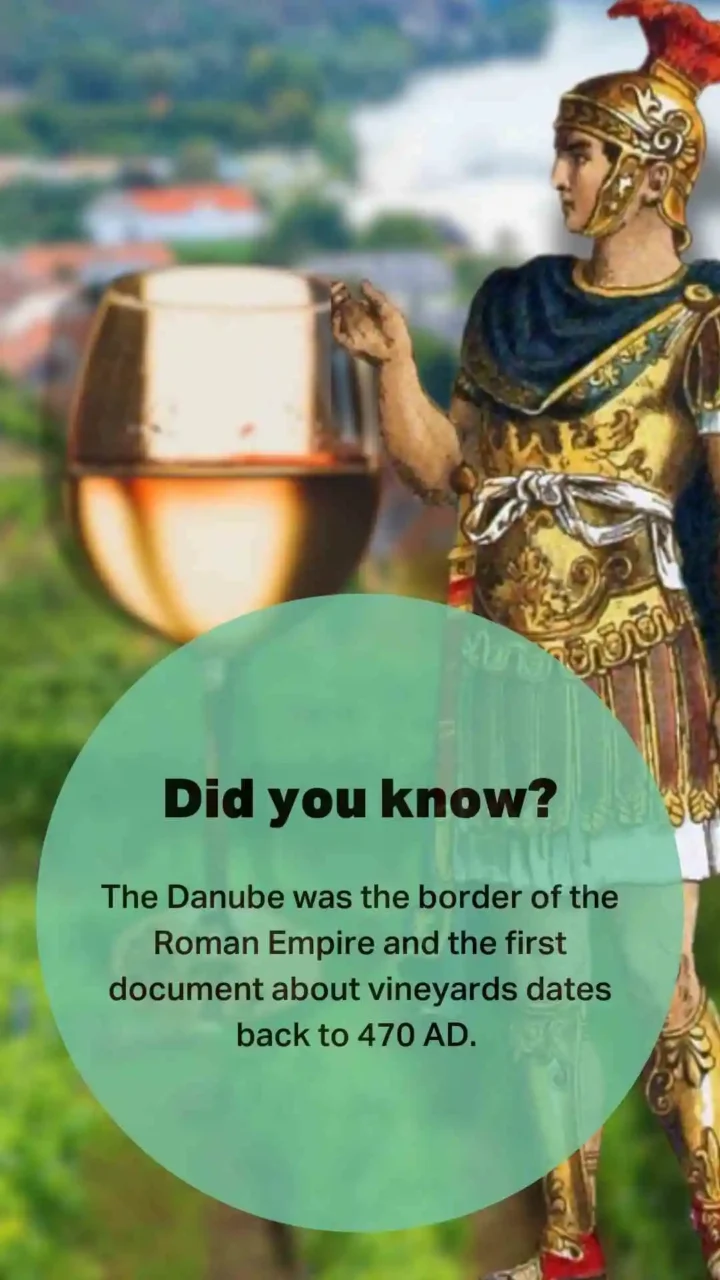
Did you know?
Krems boasts the oldest wine-makers‘ guild in the German-speaking world.
Wachau Apricots
Wachau apricots hold a special place in the Wachau region of Austria, where the law carefully protects this cherished fruit. Additionally, the cultivation of apricots in this area dates back to 1509, with significant growth occurring during the late 19th century. Furthermore, local varieties, such as the ‘Klosterneuburger’ and the ‘Pineapple Marille,’ are known for their exceptional quality and unique flavor.

The Original Wachauer Apricot Association protects and promotes these apricots, ensuring proper growth and harvest methods. Apricot farming, along with wine-making and tourism, is important to the region’s economy. Many people visit Krems an der Donau during the blossom season. At this time, over 100,000 apricot trees in the area bloom, creating a beautiful sight that attracts many people.
Did you know?
There was once a settlement called Die Wachau in North America. Today, the city goes by the name Winston-Salem and is the fifth-largest city in North Carolina. This city is also the birthplace of Camel cigarettes.
Kremser Senf
A Culinary Heritage
from Krems an der Donau
Kremser Senf is a famous mustard from Krems an der Donau, known for its special taste and long history. Made from yellow and brown mustard seeds, sweetened with sugar, and balanced with wine vinegar, this mustard has been produced for over half a millennium. Interestingly, vineyard owners began using grape must instead of vinegar in their mustard recipes, contributing to its distinct flavor. By the time of Emperor Maximilian, Kremser Senf had gained widespread fame. Moreover, in the 19th century, the Gebrüder Hietzgern brand became the best-known in the world. Following World War II, Mautner Markhof resumed its production, now making 650-700 tons a year using only Austrian ingredients. Commonly referred to as „sweet mustard,“ Kremser Senf holds significant importance to the local culture and history.

Kremstal
The Kremstal in Lower Austria features a valley shaped by the Krems River, stretching from the rugged terrain of the Waldviertel region to the vineyards near the Danube. Known for its DAC Kremstal wines, this area also boasts significant historical sites like the Gudenushöhle cave. In this cave, archaeologists discovered Austria’s oldest musical instrument, a 70,000-year-old bone flute.
Did you know?
Egon Schiele went to high school in Krems. Egon Schiele is among the most important Austrian painters.
Coat of Arms of
Krems an der Donau
On 1 April 1463, the Roman-German Emperor Frederick III gave the city of Krems a new coat of arms. This coat of arms, with an armoured, red-tongued golden double-headed eagle with the imperial crown over its heads on a black background, is still in use today.
Did you know?
At that time, Krems was extremely wealthy, with tax revenues greater than Vienna.

Ancient Krems an der Donau
The Krems area in Austria has a long history of human habitation, from the Paleolithic to the Hallstatt culture. Furthermore, this region was home to many different cultures, including Celts, Germans, Lombards, Slavs, and Romans. Notably, the area has some amazing archaeological finds, including the 32,000-year-old „Venus of Galgenberg“ and the 25,000-year-old „Venus of Willendorf,“ both discovered near Krems.
Did you know?
Krems area is also home to Austria’s oldest known burial site, an Ice Age grave that dates back 27,000 years.

Photo by Bengt Oberger, CC BY-SA 3.0 AT, via Wikimedia Commons
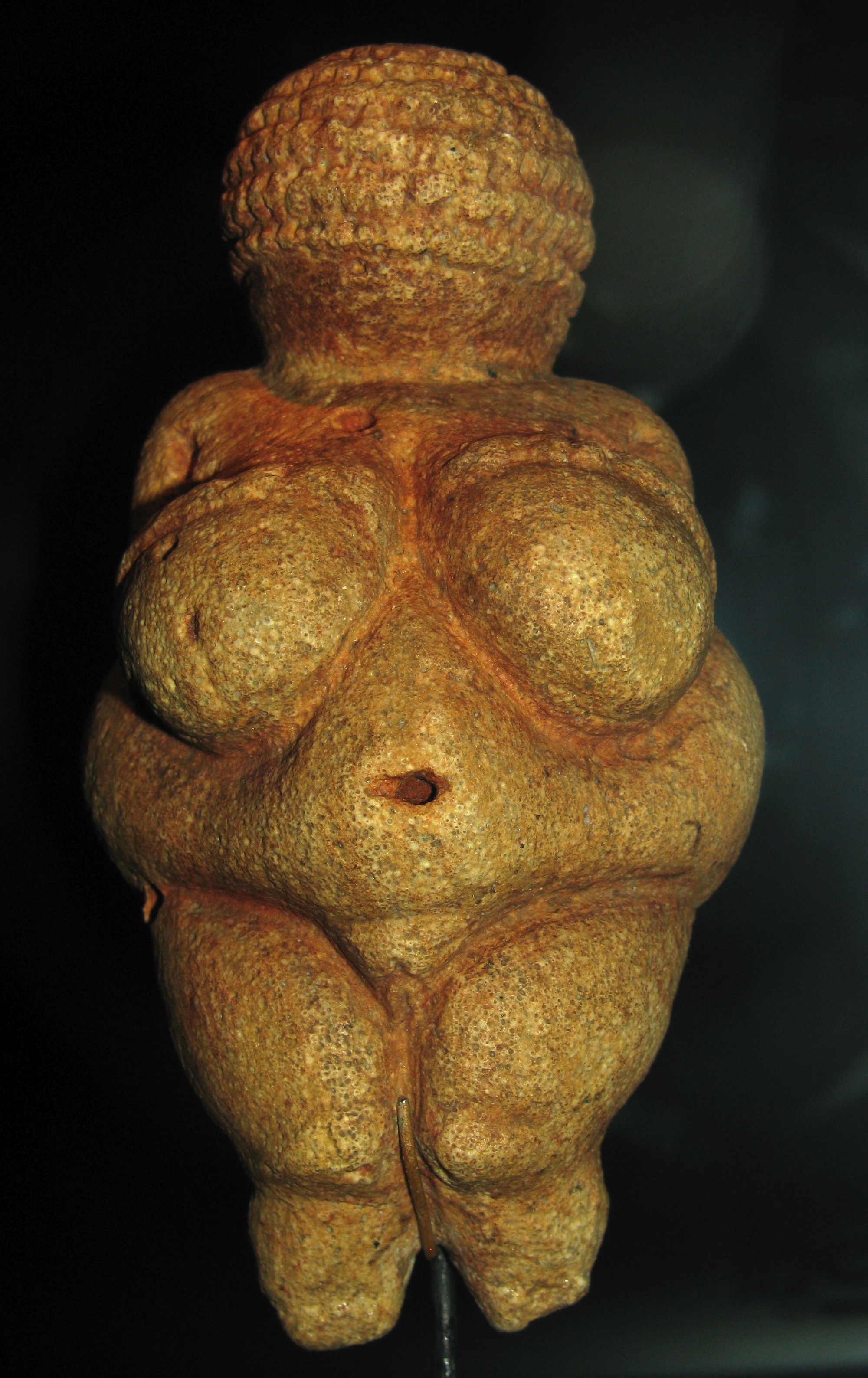
Photo by Don Hitchcock – Own work, CC BY-SA 4.0, Link
Roles of Krems an der Donau
and Stein
Today’s Krems an der Donau consists of two unique medieval towns, Krems and Stein. Due to their location, the neighboring cities of Krems and Stein have had different roles. Stein was on a river, so it was good for customs and managing ships. Stein, has been a toll collection point since 1072. Krems had good land for farming and more people could live there.
Did you know?
Krems is the oldest town in Lower Austria and one of the oldest in Austria. Moreover, a document from 995 mentions the castle “Chremis.” Subsequently, the community in Krems established the parish around 1014.
By 1150, Krems was a major trading centre. Additionally, the Babenbergs minted their first coin, the “Kremser Pfennig,” between 1130 and 1190. Furthermore, the city grew, and the parish moved to the new St. Vitus Church in the 12th century. Consequently, by the end of the century, the city had established its walls and recorded its first city judges in 1196. Moreover, the city expanded from Steiner Tor in the west to the Krems River in the east.

Photo by KathaKrems – Own work, CC BY-SA 4.0, Link
The site of the old mint can still be visited today.
Did you know?
In 2015, Krems’ Old Town shopping street achieved recognition as the most popular shopping street in Lower Austria.
Stein developed from a high terrace down towards the Church of St. Nicholas, which became a parish church in 1283. During the Middle Ages, the area between the road and the river saw lots of building work, which helped the town to grow. This included the Minorite monastery (founded in 1223/1224 and consecrated in 1264) and buildings between Reisperbach and Linzertor.
Krems an der Donau and Stein served as the country’s economic and administrative center for a long time. It notably produced the first Babenberg coins, marking its significance in the region’s economic history.

Krems an der Donau and Stein
From the 12th century, Krems and Stein were important trade hubs on the Danube. Their partnership is unique. Both towns kept their own parishes and laws but united under a common mayor starting in 1416. In 1463, Emperor Frederick III gave both cities a common emblem: a golden double-headed eagle on a black background. This symbolises their prestige and uniqueness. Only Krems-Stein, Wiener Neustadt and Vienna had this privilege.
Did you know?
Krems has lots of cafes and pastry shops compered to its size. Consequently, in 2021, it was named the sweetest city in Austria.
Wealth of Krems an der Donau
The economy of Krems and Stein flourished through vineyards, wine production, and trade in salt and metal. Moreover, Stein gained significance through its shipping activities. In 1463, Stein achieved the significant milestone of obtaining the right to build a bridge, a notable accomplishment outside Vienna. Furthermore, the cities’ wealth manifested in their architecture, exemplified by the Gozzoburg, a castle-like residence constructed by Gozzo von Krems. Additionally, the region featured houses adorned with sgraffito and frescoes, as well as arcaded courtyards used by monasteries and dioceses for wine storage and property management. By 1500, Krems emerged as a center of Danube art, influenced by the works of Jörg Breu from Augsburg.
Did you know?
The privilege to build a bridge across the Danube was the second of its kind in Austria after Vienna.

Krems an der Donau
as Protestant Bastion
In the 16th century, Krems was predominantly Protestant. In 1589, a significant religious event took place in the city. Melchior Klesl (Bishop of Vienna) came and urged the townspeople to return to Catholicism. However, about 600 residents disagreed and sought the city’s help. Consequently, Klesl used soldiers to take control of Krems.
The city suffered greatly for this resistance. Consequently, after a long trial in 1593, Krems lost its special rights and had to pay a fine. As a result, four people were jailed, lost their rights, and forfeited half their property. Furthermore, many Protestants left the city. However, in 1613, Krems regained its rights, and in 1615 it made an agreement with the authorities.
Did you know?
The Wachau Valley in Austria celebrates the summer solstice every year. Moreover, this festival draws around 40,000 visitors and features stalls selling local food and drink, illuminated vineyards, and boats decorated with lights on the Danube.
In 1615, Emperor Matthias changed the situation and restored the city’s autonomy. Subsequently, the Jesuits, who settled in Krems in 1616, played an important role in the renewal of Catholicism. They ran a school and organized theatre performances.
During the Counter-Reformation, Jesuits established a college and the Capuchins founded a monastery in 1614. Italian artists contributed to the construction of an early Baroque parish church during this period.
The 17th century saw Krems struggling with economic issues due to altered trade routes and decreased goods crossing the Danube River. Consequently, in 1645, Swedish forces attacked and wrecked the city. However, the next year, Krems regained stability. Post-1700, Krems began to thrive again with a Baroque-style reconstruction. Moreover, local artists and craftsmen, including the renowned painter Martin Johann Schmidt, played key roles in revitalizing the city through their work for large monasteries.
Did you know?
The Kalmuck Janker, originally used by Mongolian Kalmyks as saddle blankets, arrived in the Wachau region around 1730. Consequently, winemakers in Lower Austria transformed this durable fabric into jackets. Today, this fabric remains integral to traditional costumes and everyday clothing, symbolizing Lower Austrian heritage.

The 18th Century
The 18th century saw significant changes in church ownership and structure. The Piarists took over the Frauenberg church in 1776 due to the dissolution of the Jesuits in 1773. Subsequently, in 1783, the authorities closed the Dominican monastery, followed by the closure of other monasteries in 1796.

Martin Johann Schmidt
Martin Johann Schmidt, also known as Kremser Schmidt, was a renowned painter. Consequently, he was an important figure in the Austrian Baroque and Rococo periods. Born on 25 September 1718 in Grafenwörth and passing away on 28 June 1801 in Stein an der Donau, Schmidt’s artistic journey left a lasting impact. Remarkably, despite lacking formal training, he was accepted into the Vienna Academy of Fine Arts. His work, primarily depicting religious scenes, captivated audiences with its vivid colors and profound depth, reminiscent of Rembrandt’s style. Schmidt’s artistic legacy endures, with his finest pieces adorning the abbeys of St. Paul, Göttweig, and Seitenstetten, illustrating his significant influence on Baroque art during his era.
Did you know?
Amadeus Mozart’s grandmother was from Stein; she was born at Steiner Landstrasse 74.

The 19th Century
The city changed a lot in the 19th century. The only remaining gate is the Steinertor Gate, which now symbolizes the city. Builders erected new factories, such as a leather factory in Rehberg and a mat and carpet factory in Stein. Renowned craftsmen crafted organs and bells. In the late 19th century, the city acquired a railway line, and in 1909, a new line opened along the Danube.
Did you know?
The fire brigade in Krems, established in 1861, holds the distinction of being the oldest in Lower Austria.

After the Second World War
Krems, emerged as a stronghold of the NSDAP in the early 1920s. Despite the NSDAP ban in 1933, Krems maintained its importance and served as a center for the illegal movement. Hitler visited Krems once and bypassed the city during his march to Vienna in March 1938.
After the Anschluss, Krems prominently featured in Nazi propaganda and held the status of Gau capital. “Gau” was an administrative unit within the organisational structure of the National Socialist German Workers’ Party (NSDAP). There were plans to expand Krems an der Donau to accommodate its new role and increase its importance in the region. However, due to the outbreak of the Second World War, these plans were not realised. The seat of the Gauleitung was later moved to Vienna, which reduced the role of Krems an der Donau as the administrative centre of the Reichsgau Niederdonau.
In 1938, the districts of Krems and Pöggstall overwhelmingly supported the annexation to Nazi Germany, with 99.975% voting in favor. However, this result did not reflect the true will of the people, as the vote was not conducted democratically.
During World War II, bombs damaged Krems, leading to the renovation of many old buildings. The area near the train station suffered the most damage, resulting in approximately 100 deaths.

Photo by Kolchak1923, Public domain, via Wikimedia Commons
The tomb of Adolf Hitler’s parents, removed in 2012.
The Jewish Heritage
of Krems an der Donau
From the 13th century, Krems had a Jewish community with a synagogue and cemetery, jewish people were engaging primarily in banking and trading. Persecution started in 1293 and culminated in a 1349 pogrom during the plague. In the 15th century, anti-Semitic actions led to the expulsion of Jews, and their properties became church holdings. Jews began returning to Krems after 1848, but their community size dwindled after World War I. Following the 1938 Anschluss, most Jews fled, and those remaining faced deportation to Vienna. The Jewish cemetery, established in 1880/81, experienced desecration during the Nazi regime. In 1978, a bank took the place of the demolished synagogue. Renovations in 1988 restored the cemetery, which now includes a memorial for the 127 Jews expelled or murdered.
Did you know?
In 1421, Duke Albert V of Austria initiated a campaign against Jewish communities in the region, marking a dark chapter in Jewish history. Authorities accused Jews of involvement in the Hussite Wars, committing ritual murders, and desecrating the Eucharist, leading to widespread persecution. In May 1420, authorities actively apprehended numerous Jews in the vicinity. By June, they were actively expelling poorer Jews, while wealthier ones faced active imprisonment. Then, in March 1421, a horrific event unfolded in Vienna, where 92 men and 120 women actively met their demise at the stake. Survivors actively confronted either execution or exile, and their properties faced active confiscation. Synagogues and other places of worship were actively subjected to destruction. Many Jewish families fled Austria, leaving behind estates that Christians later took over.

Austria’s Largest Camp
in Krems an der Donau
STALAG XVII B, located in Gneixendorf, now part of Krems an der Donau, was Austria’s largest prisoner-of-war camp. Its prisoners occupied wooden barracks with three-tiered bunk beds, enclosed within various sections by barbed wire, vigilantly monitored by guards stationed in watchtowers. Tragically, nearly 2,000 individuals perished within the camp due to disease and hunger.
Initially functioning as a transit point for prisoners in September 1939, STALAG XVII B received its official designation on 26 October of the same year. Later, in October 1943, authorities established a new sub-camp to accommodate 4,300 American non-commissioned officers. The camp’s operation concluded with the end of the Second World War, as the Red Army breached its walls on 9 May 1945, liberating the prisoners. Following the liberation, the barracks were dismantled.
Support
This website cannot exist without your support. If you have the opportunity, please support us financially.
What to See in
Krems an der Donau
Bundesgymnasium und
Bundesrealgymnasium
The Bundesgymnasium und Bundesrealgymnasium Krems, located in Krems an der Donau, is a prestigious general education school. Specializing in humanities, science, and languages, the school building was erected in 1694 and holds the status of a protected cultural monument. Over the years, it has undergone expansion, renovation, and modernization, resulting in the addition of new facilities such as computer rooms, a theatre, and a library. Notable milestones in its history include its founding by the Jesuits in 1616 and its transformation into a state gymnasium in 1871. The school has maintained its commitment to academic excellence and cultural preservation throughout its existence.
Photo by Bauer Karl – Own work, CC BY-SA 3.0 at, via Wikimedia Commons
The Holy Trinity Column
The Holy Trinity Column in Krems, made by sculptor Josef Matthias Götz in 1738, shows the residents’ gratitude for protection against plagues and ills. This Eggenburg stone column is divided into three sections, inspired by similar plague columns across Austria. Each section represents the Earthly Realm, the Immaculate Mary, and the Holy Trinity. The column also has statues of St. Vitus, St. Nepomuk, and St. Charles Borromeo, the city’s patrons.
Photo by Bauer Karl – Own work, CC BY-SA 3.0 at, via Wikimedia Commons
Göglhaus:
The Gem of Krems an der Donau
The Göglhaus in Krems an der Donau boasts a lengthy history, originally belonging to the Eggenburger family. The main entrance features a late Gothic portal crafted between 1487 and 1511 by Mert Eggenburger. Adorning the Göglhaus façade are sculptures and groups dating back to around 1520, depicting Habsburg and Imperial symbols. Inside and within the courtyards, visitors can observe preserved medieval structural elements. Additionally, rare Renaissance barrel or cell vaulting can be found. Prior to the construction of the current town hall, the Göglhaus served as a court and government building.

Photo by Palickap – Own work, CC BY-SA 4.0, via Wikimedia Commons
Krems City Hall
The town hall of Krems an der Donau, located in the church square south of the parish church and Kremser Landstraße, has a fascinating history dating back to the 15th century. Originally acquired by Margarethe von Dachsberg in 1419, the decision to build a new town hall took nearly a century to materialize. Constructed in the Renaissance style, the town hall boasts interior columns adorned with Renaissance capitals. Notably, the southwest corner features the rathauserker (town hall bay), adorned with the Habsburg and Krems coats of arms, flanked by reliefs. In 1782, the town hall underwent a Baroque-style reconstruction, further enhancing its architectural appeal.

Photo by Isiwal, CC BY-SA 4.0, via Wikimedia Commons
Bürgerspitalkirche
Landmark in Krems an der Donau
The Bürgerspitalkirche in Krems an der Donau stands as a Roman Catholic church in the city center, dedicated to Saints James and Philip. Notably, it was constructed on the site of houses razed after the expulsion of Jews in 1470, showcasing Emperor Frederick III’s motto, A.E.I.O.U. The structure boasts remarkable vaulting and internal buttresses, ingeniously designed to grace the building without obstructing the main street. Inside, the main altar features a 19th-century painting depicting Saints Philip and James, flanked by statues of Saints Nicholas and Wolfgang. Additionally, the church is adorned with a double-leaf sacramental niche featuring 15th-century metal doors.

Photo by Bauer Karl, CC BY-SA 3.0 AT, via Wikimedia Commons
St. Vitus Parish Church in Krems
The Pfarrkirche St. Veit, also known as the “Wachau Cathedral,” holds a rich history. Emperor Henry II donated land for its construction in 1014. Initially named the “Mother of the Parish,” it was later renamed Saint Vitus in 1178. Milanese architect Cypriano Biasino designed the current building, which was constructed between 1616 and 1630 in the early Baroque style. The church houses artworks from the 18th century, including paintings by Martin Johann Schmidt, and Johann Georg Schmidt crafted the altar. A black marble altar from the Capuchin monastery chapel in Und stands on the left side of the church, adorned with statues of the Virgin Mary and St. Anne. Additionally, a small chapel on the northeast side of the church features a 14th-century Gothic statue of Anna.

Photo by Bauer Karl in the German Wikipedia – Own work, CC BY-SA 3.0 AT, via Wikimedia Commons
Piaristenkirche Krems
The Piaristenkirche holds significant historical importance for Krems an der Donau. Dating back to 1014, it originally honored St. Stephen, the patron saint of the Diocese of Passau. The current structure, built in 1694, integrates elements from the Romanesque west tower. During the Middle Ages, builders from the Vienna Cathedral expanded the church. In the 18th century, the Piarists took over from the Jesuits. The interior showcases artwork by Martin Johann Schmidt, including the altarpiece “The Assumption of the Blessed Virgin Mary” (1756) and a fresco in the chapel of St. Francis Xavier. The crypt contains bones from 68 graves.
Did you know?
It is the only church tower in Austria that does not have a cross on top but instead bears the city’s coat of arms.
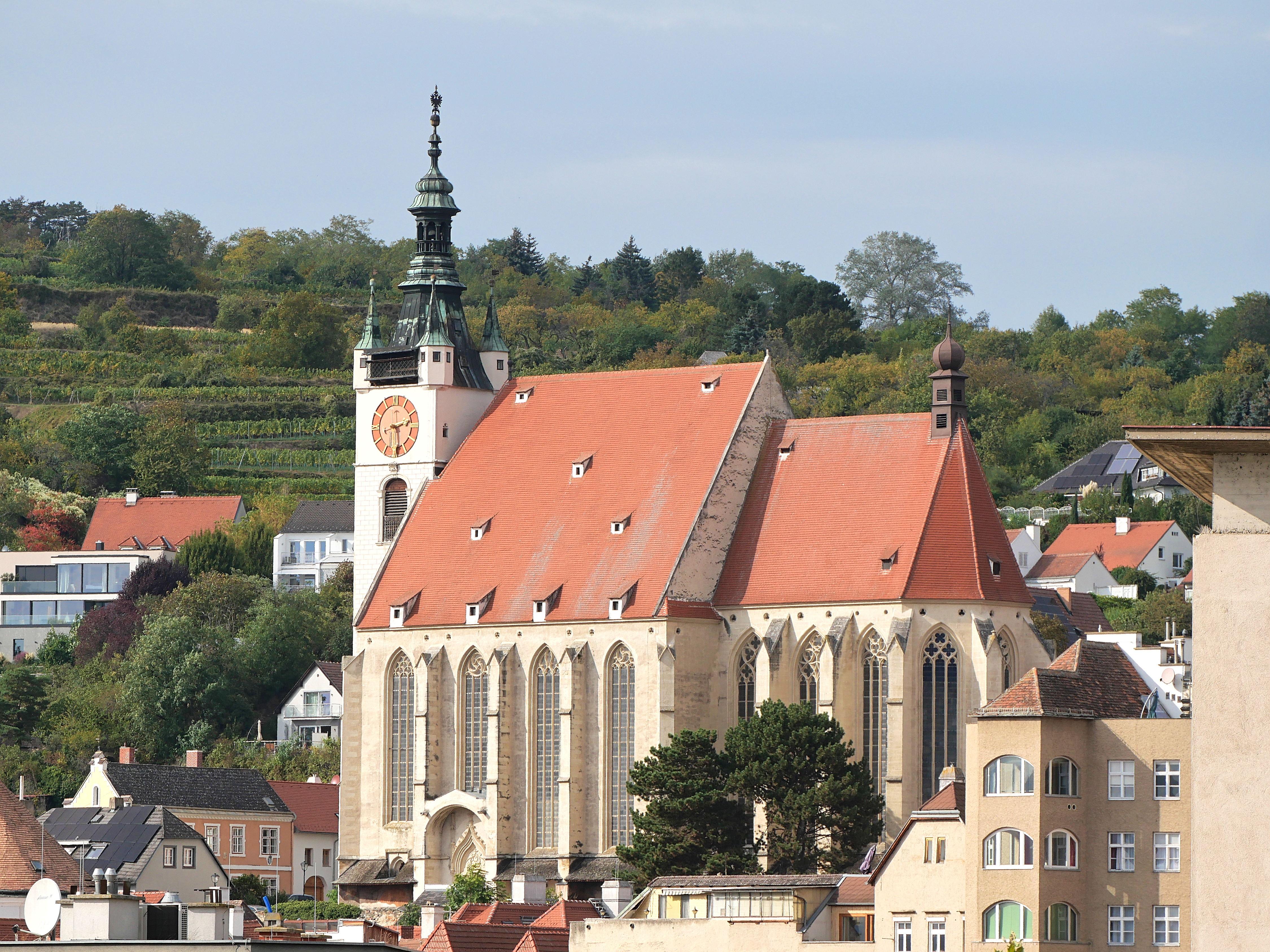
Photo by Herbert Ortner – Own work, CC BY 4.0, via Wikimedia Commons
The Great Sgraffito House
In 1554, Hans von Drackh, a wealthy Protestant merchant, renovated his Krems residence in the Renaissance style. Subsequently, Flemish artist Hans von Brugg adorned the house with sgraffito. These intricate designs depict scenes from the Bible, Greek mythology, daily life, and historical figures. Notable illustrations include King Saul, Judith with the head of Holofernes, Lucretia, and the legendary scene “Fuchs predigt den Gänsen” (The Fox Preaches to the Geese). Remarkably, these sgraffito were rediscovered in 1925 and now stand as a cherished part of Krems’ rich history.
Gozzoburg
Gozzoburg in Krems an der Donau is a medieval building, constructed after 1235. It features an L-shaped core with late Romanesque elements, including a raised entrance and three arched windows. In the 13th century, Gozzo von Krems, a local judge, transformed it into a grand palace. By 1320, Gozzoburg became part of the Habsburg estate and frequently changed hands in the 15th century. Following damage incurred during a siege in 1477, Gozzoburg was rebuilt.
Did you know?
During restoration works, workers uncovered exceptionally well-preserved frescoes, some of the oldest in Central Europe, depicting the legend of Barlaam and Josaphat.

Photo by Wolfgang Sauber – Own work, CC BY-SA 4.0, via Wikimedia Commons
Simandl Fountain
Erected in 1929 by Viennese sculptor Franz Zelezny, the Simandl Fountain stands as a tribute to the 400th anniversary of the founding of the Simandl Brotherhood. Additionally, this remarkable monument adds to the city’s cultural heritage and serves as a poignant reminder of its rich history.
Did you know?
The Simandl Brotherhoods were founded in 1517 by Siegmund von Dietrichstein, the governor of Lower Austria and son-in-law of Emperor Maximilian I. They aimed to encourage men to behave morally. The brotherhoods encouraged members to drink and swear less. In the 18th century, such brotherhoods gained popularity in Vienna and Lower Austria, with their main headquarters in Krems. Their efforts changed social behaviour and local culture during this period, making people more disciplined and respectful.
Legend
In Krems an der Donau, the Simandla Fountain is a memorial to Simon Handel, who was submissive to his wife Holden. In 1528, the men asked the city for help. This led to the tradition of buying gifts for their wives during the Simonimarkt market. This practice became the annual meetings of the Simandl Brotherhood, showing the city’s sense of humour about marriage.
Powder Tower
The Powder Tower in Krems an der Donau dates back to the 15th century and is located at the northeastern corner of the old city walls. Originally, it functioned as a battery tower with a flat roof, which was later replaced by a conical roof in the 18th century. The gunpowder storage was relocated to Gneixendorf in 1752, where it eventually exploded in 1851. Today, the tower stands as a prominent landmark, especially notable when viewed from the east.
Photo by Tyssil – Own work, CC BY-SA 3.0, via Wikimedia Commons
Former Dominican Church
The Dominican Church in Krems, constructed around 1240, has a rich history. Initially serving as a monastery for the Dominican Order and dedicated to Saints Peter and Paul, the church features three naves and blends Gothic and Baroque styles. During the Reformation, it functioned as a warehouse and later transformed into a theatre and cinema. The monastery closed in the 18th century due to secularization. Since 1969, the church has hosted museums and cultural events. Its Zacken-style wall paintings are regarded as Austria’s finest examples of this artistic style.
Zackenstil, also known as the “jagged style,” originated in German-speaking regions during the 13th century. This style is renowned for its zigzag drapery, which conveys a sense of movement and vitality. Zackenstil drew inspiration from Byzantine and Western German traditions and evolved alongside Gothic architecture. Noteworthy examples include the Saxon Gospels in Goslar and the fresco depicting the Coronation of Mary in the Dominican Church in Krems, dating back to around 1280.
Did you know?
The church has Austria’s oldest roof tiles.

Photo by Jakub Hałun – Own work, CC BY-SA 4.0, via Wikimedia Commons
Steiner Tor: The Icon of Krems
The Steiner Tor stands as a prominent landmark in Krems an der Donau, originally serving as a city gate since the Middle Ages. During Maria Theresa’s reign in 1756, it was given its current Baroque style, including a tower adorned with the Habsburg emblem. Additionally, the gate’s portal displays the initials A.E.I.O.U. and the year 1480, marking the city’s defensive wall reconstruction after the 1477 Hungarian assault. Historically, this area faced frequent flooding from the Danube, and a stone marker commemorates the significant flood of 1573.
Did you know?
The mysterious acronym A.E.I.O.U. connects to Emperor Frederick III of the Habsburg dynasty. Interestingly, this sequence of vowels appears on many Habsburg-related sites, including the castles of Wiener Neustadt, Graz, and Linz. However, the meaning of A.E.I.O.U. remains unclear. Nevertheless, a widely accepted interpretation of A.E.I.O.U. states it as “Austriae est imperare orbi universo,” which means “Austria is destined to rule the world.” Ultimately, this phrase reflects the Habsburgs’ grand ambitions and their long history as a powerful dynasty.
Photo by C.Stadler/Bwag – Own work, CC BY-SA 4.0, via Wikimedia Commons
Und Monastery in Krems
The Und Monastery in Krems, has a long history. It was first a Capuchin monastery and a Marian pilgrimage destination. Today, it is a busy place for events, food, and wine. In 1614, Emperor Matthias approved the Capuchins’ settlement in a strategic spot between Krems and Stein. The architect Mathias Piazolli designed the monastery, which was important during the Counter-Reformation.
The Chapel of Grace, built in 1643 by Archduke Leopold Wilhelm, is one of the monastery’s most important features. Notably, it was once the home of a Mother of God statue that survived a fire in 1656. However, the monastery stopped holding religious services in 1796. As a result, its valuable items, including a large black marble altar, were transferred to St. Vitus’s church in Krems. Additionally, the name Und is a tribute to Sancta Maria ad undas, which means “Holy Mary near Waves.”

Photo by Jakub Hałun – Own work, CC BY-SA 4.0, via Wikimedia Commons
Heilandskirche
The Heilandskirche in Krems, an exemplary piece of early 20th-century architecture designed by Otto Bartning, stands as a testament to the era’s architectural prowess. Constructed in 1913, this church features a central plan and a distinctive roof turret, showcasing its unique design elements. Upon entering, visitors are greeted by a bright and inviting interior adorned with simple classicist accents. The architectural concept aimed to foster a sense of community centered around the pulpit and altar, emphasizing unity among worshippers. Notably, in 1985, the altar was relocated to facilitate a communal Lord’s Supper, further enhancing the sense of togetherness within the congregation. Adjacent to the church, the Cross of Tolerance serves as a poignant reminder of Joseph II’s 1781 tolerance law, which advocated for harmony among different faiths.
Photo by C.Stadler/Bwag – Own work, CC BY-SA 4.0, via Wikimedia Commons
The Donauuferbahn
The Donauuferbahn, a renowned train line in Austria, runs from Sankt Valentin to Krems an der Donau. Since 1898, it has been celebrated for its route along the Danube River, as it traverses the picturesque Strudengau, Nibelungengau, and Wachau regions. This line stands as a 19th-century engineering feat, featuring 32 bridges and tunnels. In particular, the Teufelsmauer Tunnel holds the distinction of being the shortest, measuring just 12.43 meters. Additionally, the Wachaubahn section, stretching from Krems to Emmersdorf, offers stunning views of the Danube River, vineyards, and castles. Furthermore, in 1908, during the railway’s construction, workers discovered the Venus of Willendorf, a Stone Age statue, marking one of Europe’s most significant archaeological finds.
Did you know?
The Teufelsmauer Tunnel, near Spitz, is the shortest tunnel in the ÖBB railway system.

Photo by Linie29 – Own work, CC BY-SA 4.0, via Wikimedia Commons
Justizanstalt Stein
The Justizanstalt Stein is a large prison in Austria. Specifically, the prison in Krems an der Donau, Lower Austria, stands as the second-largest correctional facility in the country, and it was constructed in 1850 on the grounds of a former monastery. Moreover, it primarily accommodates male inmates serving sentences exceeding 18 months, including those serving life sentences.
Did you know?
The April 1945 Stein Prison Massacre marks a tragic chapter in its history. As the Red Army was approaching, the prison director, Franz Kodré, received permission to release non-threatening prisoners. The release process began on April 6, but the NSDAP responded with violence. Consequently, Nazi authorities ordered the execution of 229 inmates and some staff members. As a result, this event led to the “Kremser Hasenjagd,” a brutal hunt for the freed prisoners, resulting in numerous deaths. In fact, estimates suggest that 500 to 650 people lost their lives during this period.
Museum of Caricatures
The Krems Museum of Caricatures is the only Austrian museum dedicated to satirical art. Consequently, its exhibits primarily focus on political satire, comical sketches, comic strips, and artistic illustrations. It shares the neighborhood with the Kunsthalle Krems and the Landesgalerie Niederösterreich, thus integrating into the local arts scene. Moreover, designed by Gustav Peichel, an architect and satirist, the museum opened on 29 September 2001.
Kunsthalle Krems
Kunsthalle Krems is an international exhibition venue in Stein an der Donau, Austria. Moreover, it opened in 1995 in a former tobacco factory designed by Adolf Krischanitz. After undergoing a €3.5 million renovation, the Kunsthalle reopened its doors on 1 July 2017. Additionally, situated in the Krems art district alongside the Caricature Museum and the Landesgalerie Niederösterreich, it specializes in post-1945 art, with a particular focus on contemporary works. It is a platform for established and up-and-coming artists from around the world. Its exhibitions include many different types of art, such as painting, drawing, sculpture, photography, video, film, performance, and installations. The Kunsthalle works with the Donaufestival to show how art can be used in different ways.
Photo by C.Stadler/Bwag – Own work, CC BY-SA 4.0, via Wikimedia Commons
Minoritenkirche in Stein
The Minoritenkirche in Stein an der Donau originally served as a monastery church of the Order of Friars Minor. However, it now functions as a cultural venue known as Klangraum Krems. Although founded around 1230, the church was consecrated in 1264 and has undergone numerous alterations throughout its history. In addition, it exhibits late Romanesque and early Gothic styles, featuring a single-nave chancel and a southern tower topped with a Baroque helmet. Moreover, inside, visitors can admire wall and vault paintings dating back to the 1950s, contributing to Krems’ cultural heritage. After 1796/1797, the church was repurposed for various uses, including as a tobacco warehouse. Since 1992, it has been utilized for exhibitions and concerts, serving as a focal point for cultural events.
Photo by C.Stadler/Bwag – Own work, CC BY-SA 4.0, via Wikimedia Commons
Frauenbergkirche in Stein
The Frauenbergkirche Mariae Himmelfahrt in Stein an der Donau has been a war memorial since the 1960s. It was built in the 14th century on the cliffs above St. Nicholas Parish Church. You can get to it by steep stairs. The church has Gothic architecture and is a memorial to those who died in the 1st and 2nd World Wars. The bell, cast in Vienna in 1782, still rings. Frauenbergkirche has a rich history and cultural significance. It is a place for worship and reflection on past conflicts.

Photo by Wachauer – Own work, CC BY-SA 3.0, via Wikimedia Commons
Parish Church of St. Nicholas
The Roman Catholic Church of St. Nicholas in Stein an der Donau is a historic church in the Danube Valley, near Krems an der Donau. Originally, it was first documented in the 12th century and became a parish in 1263. For several centuries, it served as the church for Krems until the late 16th century. Additionally, the Gothic choir is from the 14th century, while the hall dates to the 15th century. The church features a late-Gothic west tower and Baroque elements from the 18th century, and it was regothicised around 1900. Furthermore, the church has large buttresses, tracery windows, and a Baroque tower with an onion dome. Inside, the interior includes three naves and four bays, with moulded ogival arches, a net vault, and coats of arms on the bosses. Moreover, the church is also known for its many gravestones on the outside.

Photo by Isiwal – Own work, CC BY-SA 4.0, via Wikimedia Commons
Ruins of Stein Castle
The ruins of Stein Castle in Krems an der Donau, standing at 217 meters above sea level, are the remains of a 14th-century medieval fortress. References to a fort in this region date back to Roman times. First mentioned in 1336, the castle was integral to the town’s defenses. It survived multiple sieges in the 15th century but fell to the Hungarians in 1485. The Swedes invaded in 1645, and by 1646, Imperial forces had left it in ruins. Originally about 120 meters long and 40 meters wide, the castle protected the town’s western section. Today, the surviving walls and towers provide scenic views and draw visitors.

Photo by Wachauer – Own work, CC BY-SA 4.0, via Wikimedia Commons
Mauterner Bridge
The Mauterner Bridge, once called the Stein-Mauterner Bridge, is a notable landmark linking Stein (part of Krems an der Donau since 1938) and Mautern an der Donau in Lower Austria. Constructed by the Ig. Gridl factory between 1893 and 1895, it measures 374 meters long and 11 meters wide, accommodating vehicles, cyclists, and pedestrians. Historically, its significance dates back to Roman times, with a wooden bridge first constructed in 1463 under Emperor Frederick III. Later, the existing steel bridge, which replaced the wooden one in 1895, played a key role during both World Wars. Afterward, following partial destruction in 1945, it was reconstructed by German POWs under Soviet oversight. Today, the bridge is a protected historic site that has been renovated. Despite this, recent load limits still allow it to continue as an essential and scenic crossing over the Danube, reflecting the region’s rich history and engineering prowess.
Did you know?
This was the location of the first bridge on the Danube outside Vienna.
Photo by Thomas Ledl – Own work, CC BY-SA 4.0, via Wikimedia Commons
Schloss Wasserhof
Schloss Wasserhof is a historic site in Gneixendorf, now part of Krems an der Donau, with a rich heritage. First mentioned in 1170, it was owned by Otto von Machland. Later, by 1630, it came into the possession of Count Adolf von Althan. Notably, in 1819, Johann van Beethoven, a pharmacist and brother of Ludwig van Beethoven, acquired the estate. Johann spent the autumn of 1826 here, completing his String Quartet in F major, Op. 135, and revising the finale of his String Quartet in B flat major, Op. 130. Over the years, the estate changed hands several times until 2007 when Ernst Linsberger purchased it, initiating a restoration project from 2011 to 2015.
Did you know?
In 1819, Nikolaus van Beethoven, a pharmacist, bought Wasserhof Castle in Gneixendorf. Meanwhile, his brother Ludwig van Beethoven teased him about his rich lifestyle. For instance, when Johann signed New Year’s greetings as “From your brother Johann, the landowner,” Beethoven humorously replied: “From your brother Ludwig, the brain owner.
Donauwarte
The Donauwarte observation tower, standing 450 meters above sea level on the Braunsdorfer Berg in Krems an der Donau, offers spectacular views of the surrounding landscape. Additionally, this stone and timber 14-meter-high tower, built in 1884, has a viewing platform at 6.3 meters. Moreover, from here, visitors can enjoy panoramic vistas of the Danube Valley, the Tulln Basin, Krems, and the stunning Göttweig Abbey. The Austrian Tourist Club built it, and it closed in the mid-1980s because it was in bad condition. However, it reopened in 1989 after being refurbished. The Donauwarte is open all year and costs a small fee to enter.
Wetterkreuzkirche
The Wetterkreuzkirche, also known as the Wallfahrtskirche Hl. Kreuz, serves as a pilgrimage destination. Initially, it originated as a simple cross in the 15th century, gradually becoming a site where people sought divine protection against storms. In 1661, 3,500 pilgrims donated money to build a small chapel. Later, this chapel underwent expansion in 1727 to include a nave and a tower. Furthermore, from 1729 to 1782, it was accompanied by a hermitage. Additionally, the path leading up to the church features Stations of the Cross, with a crucifixion scene created by the hermit Lorenz Wagener. As a result, the church frequently experiences lightning strikes, which lead to damage.
Photo by C.Stadler/Bwag – Own work, CC BY-SA 4.0, via Wikimedia Commons
Burgruine Rehberg
The Burgruina Rehberg, located in the Krems Valley, stands as a silent witness to the region’s history. This medieval fortress sits atop a mountain ridge, offering panoramic views of Krems and its surroundings. Built in the 12th century, its walls narrate stories from the past. The castle notably survived the Thirty Years’ War because the Swedish army respected the Protestant beliefs of its owner. In the 18th century, it exchanged hands multiple times, belonging to the Rechberg family and other noble households. It also served as a residence for notable figures such as Otto von Rechberg and Emperor Maximilian I. However, over time, the castle fell into disrepair due to neglect and frequent changes in ownership. Today, the Burgruina Rehberg stands as a poignant reminder of Krems’s rich history.
Photo by C.Stadler/Bwag – Own work, CC BY-SA 4.0, via Wikimedia Commons
Join Our Vibrant Community
Are you passionate about discovering the hidden gems of Vienna and its surroundings? Follow us on social media and become part of our enthusiastic community!
Why Follow Us?
- Exclusive Content: Each post is a labor of love, taking between 10-30 hours to create. We share breathtaking photos, captivating stories, and invaluable tips.
- Stay Updated: Never miss out on exciting events, new attractions, and must-visit spots in and around Vienna.
- Support Independent Projects: We are an independent project, and your follows help us cover the costs of running this page. Your support is crucial!
Your Support Matters!
Every follow, like, and share directly supports our work. It helps us continue bringing you the best content and ensures we can keep this site running. By following us, you’re not just staying informed – you’re helping us grow and thrive.
Don’t miss out! Click the links above and start following us today. We can’t wait to connect with you!

